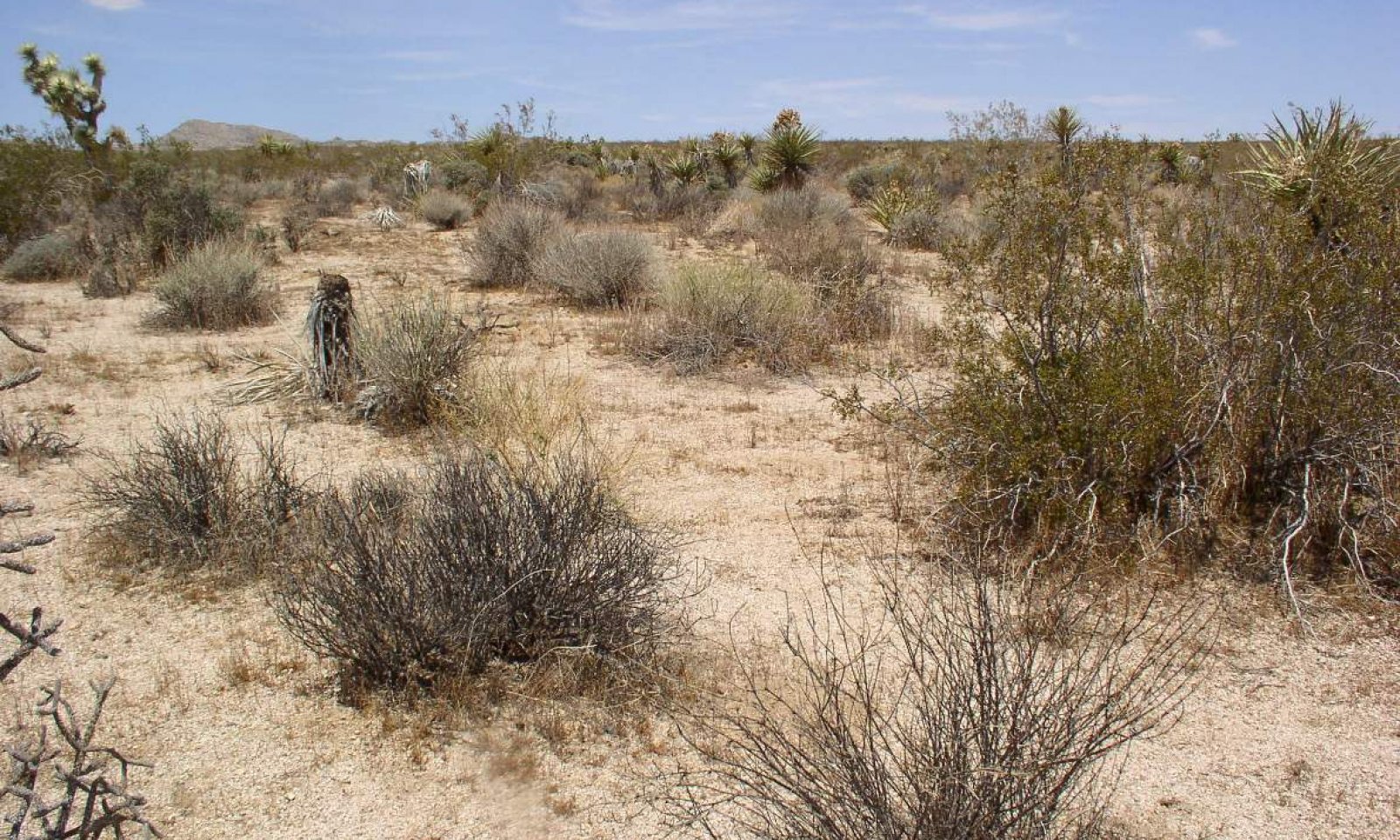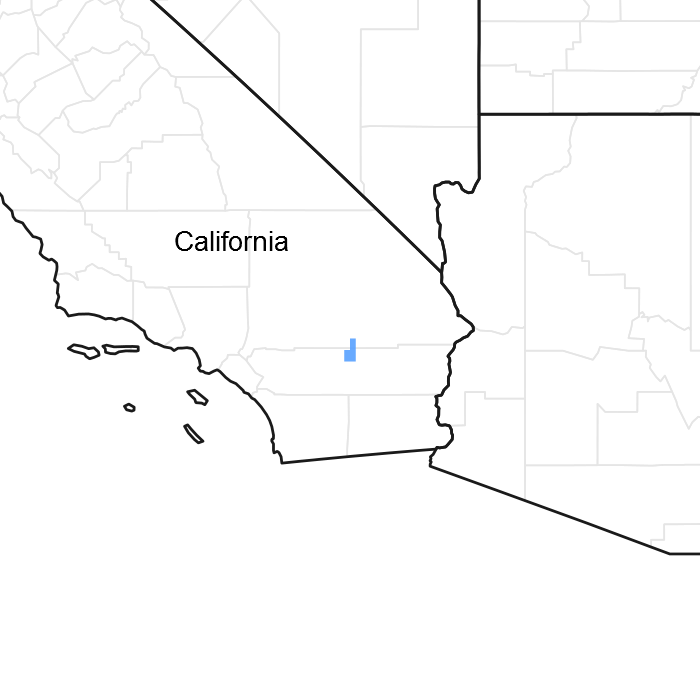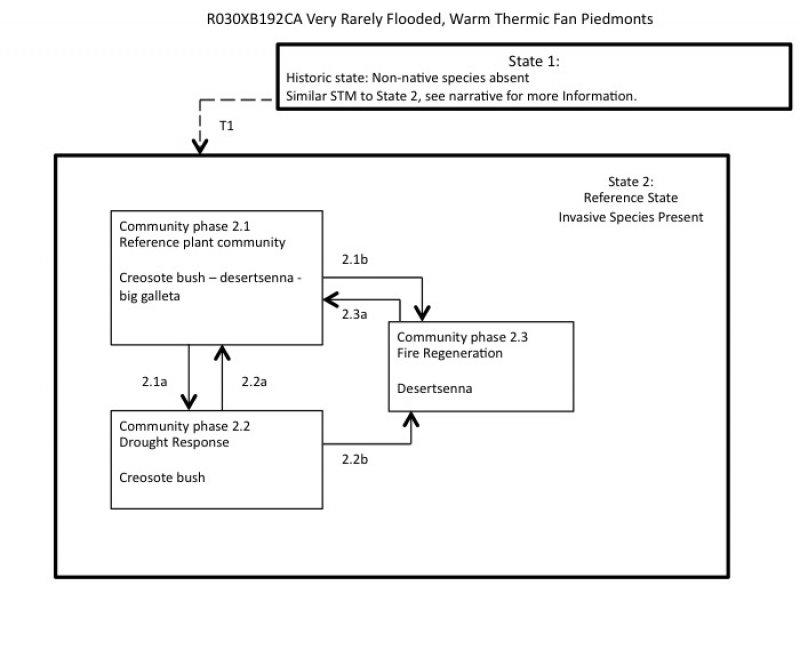

Natural Resources
Conservation Service
Ecological site R030XB192CA
Very Rarely Flooded, Warm Thermic Fan Piedmonts
Last updated: 10/21/2024
Accessed: 12/22/2025
General information
Provisional. A provisional ecological site description has undergone quality control and quality assurance review. It contains a working state and transition model and enough information to identify the ecological site.

Figure 1. Mapped extent
Areas shown in blue indicate the maximum mapped extent of this ecological site. Other ecological sites likely occur within the highlighted areas. It is also possible for this ecological site to occur outside of highlighted areas if detailed soil survey has not been completed or recently updated.
MLRA notes
Major Land Resource Area (MLRA): 030X–Mojave Basin and Range
MLRA Description:
Major Land Resource Area (MLRA) 30, Mojave Desert, is found in southern California, southern Nevada, the extreme southwest corner of Utah and northwestern Arizona within the Basin and Range Province of the Intermontane Plateaus. The climate of the area is hot (primarily hyperthermic and thermic; however at higher elevations, generally above 5000 feet, mesic, cryic and frigid) and dry (aridic). Elevations range from below sea level to over 12,000 feet in the higher mountain areas found within the MLRA. Due to the extreme elevational range found within this MLRA, Land Resource Units (LRUs) were designated to group the MLRA into similar land units.
LRU notes
This LRU (designated by ’XB’) is found across the eastern half of California, much of the mid-elevations of Nevada, the southernmost portions of western Utah, and the mid-elevations of northwestern Arizona. Elevations range from 1800 to 5000 feet and precipitation ranges from 4 to 9 inches per year, but is generally between 5-6 inches. This LRU is characterized primarily by the summer precipitation it receives, ranging from 18 – 35% but averages 25%. Summer precipitation falls between July and September in the form of rain, and winter precipitation falls starting in November and ends between February and March, also mostly in the form of rain; however it does receive between 0 and 3 inches of snow, with an average of 1 inch. The soil temperature regime is thermic and the soil moisture regime is typic-aridic. Vegetation includes creosote bush, burrobush, Nevada jointfir, ratany, Mojave yucca, Joshua tree, chollas, cactus, big galleta grass and several other warm season grasses. At the upper portions of the LRU, plant production and diversity are greater and blackbrush is a common dominant shrub.
Classification relationships
This ecological site is found within the Larrea tridentata - Ambrosia dumosa Shrubland Alliance, and specifically the Larrea tridentata - Ambrosia dumosa - Senna armata Association (Sawyer et. al. 2009).
Ecological site concept
This ecological site occurs on fan aprons and fan remnants at elevations of approximately 2100 to 4200 feet. The site experiences very rare sheet flooding. Soils are typically very deep, and have a warm thermic soil temperature regime. Production Reference Value (RV) is 244 pounds per acre, and ranges from 125 to 510 pounds per acre. The site is co-dominated by creosote bush (Larrea tridentata) and desertsenna (Senna armata), and big galleta (Pleuraphis rigida) is an important species. Sheet flooding supports a diverse plant community, providing additional moisture and establishment opportunities for species such as desertsenna and big galleta.
Data ranges in the physiographic data, climate data, water features, and soil data sections of this Ecological Site Description are based on major components only (15 percent of map unit or greater).
This is a group concept and provisional STM that also covers R030XB125CA, R030XB194CA, R030XB208CA.
Associated sites
| R030XB005NV |
Arid Active Alluvial Fans R030XB005NV is found on adjacent fan aprons. Creosote bush (Larrea tridentata) and burrobush (Ambrosia dumosa) are dominant species |
|---|---|
| R030XB174CA |
Sandy Fan Aprons R030XB174CA is found on adjacent fan aprons. Creosote bush (Larrea tridenata), Joshua tree (Yucca brevifolia) and big galleta (Pleuraphis rigida) are dominant species. |
| R030XB183CA |
Loamy Very Deep Fan Remnants R030XB183CA is found on adjacent fan remnants. Blackbrush (Coleogyne ramosissima) and creosote bush (Larrea tridentata) are dominant species. |
| R030XB188CA |
Cool Shallow to Moderately Deep Fans R030XB188CA is found on adjacent pediments overlain with alluvium. Creosote bush (Larrea tridentata) and blackbrush (Coleogyne ramosissima) are dominant species. |
Similar sites
| R030XY159CA |
Gravelly Outwash R030XY159CA occurs on sandy-skeletal soils with lower mean annual precipitation. Desert needlegrass (Achnatherum speciosum) is an important species, and jojoba (Simmondsia chinensis) is not an important species. |
|---|---|
| R030XB174CA |
Sandy Fan Aprons R030XB174CA is found in cooler climates with fewer frost free days. It is dominated by big galleta (Pleuraphis rigida), creosote bush (Larrea tridentata), and Joshua tree (Yucca brevifolia). It does not have a significant component of jojoba (Simmondsia chinensis) or desertsenna (Senna armata). |
| R030XY038CA |
Flooded Gravelly Fans R030XY038CA occurs on lower elevation sites with sandy-skeletal soils. Schott’s dahlia (Psorothamnus schottii) is a dominant species. |
Table 1. Dominant plant species
| Tree |
Not specified |
|---|---|
| Shrub |
(1) Senna armata |
| Herbaceous |
(1) Pleuraphis rigida |
Click on box and path labels to scroll to the respective text.


